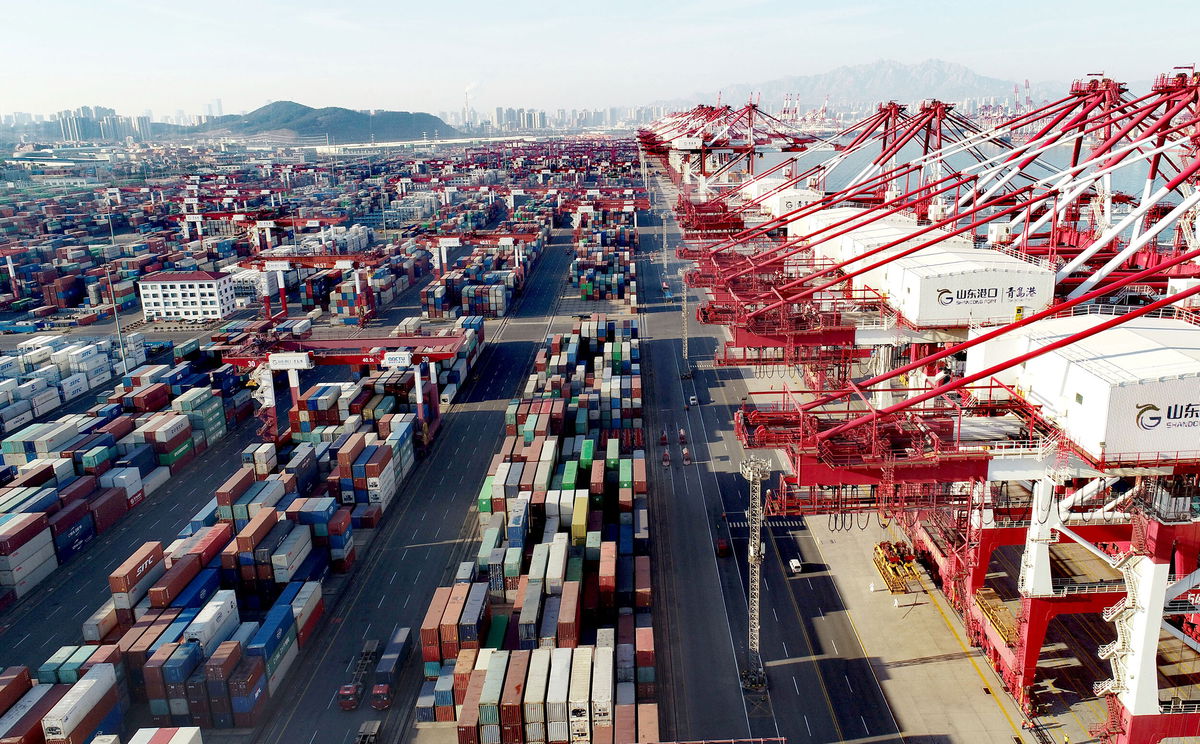Why Biden is keeping Trump’s China tariffs in place

Aerial view of shipping containers sitting stacked at Asia's first fully automated container terminal of Qingdao Port on January 14
By Katie Lobosco, CNN
President Joe Biden reversed a number of the Trump administration’s policies during his first year in office — but he has left tariffs in place on $350 billion of Chinese goods that were imposed by his predecessor.
Some of those tariffs, which are paid by American importers, have been in place for nearly four years. Former President Donald Trump’s controversial trade war with China began in 2018 when he slapped tariffs on $50 billion of Chinese-made goods. Over the next year, he added duties to more items after Beijing retaliated with tariffs on some American-made products.
After months of escalation, Trump and Chinese President Xi Jinping came to a truce at the beginning of 2020, signing what’s known as the Phase One agreement. It reduced the rate of some of the tariffs, but left them in place, and China agreed to increase its purchases of US goods and agricultural products — setting an ambitious target of buying $200 billion more than it did before the trade war began.
But it’s becoming clear that China has failed to meet those targets. It’s on track to purchase only 60% of the goods it committed to buy, according to Chad Bown, a senior fellow at the Peterson Institute for International Economics who tracks China’s purchases.
Biden suggested recently that’s the reason he’s leaving the tariffs in place, despite pressure from the American business community to remove them as companies struggle with inflation and supply chain disruptions. US importers have paid nearly $123 billion to cover the cost of the China tariffs since 2018, according to US Customs and Border Protection.
“It’s uncertain,” Biden said last week at a news conference when asked if it’s time to begin lifting some of the tariffs.
“I’d like to be able to be in a position where I can say they’re meeting the commitments, or more of their commitments, and be able to lift some of it. But we’re not there yet,” he added.
China falls short of Phase One commitments
Under the terms of the deal, China committed to ramp up its purchases of US goods and agricultural projects, setting specific amounts for different categories to be bought over the next two years.
Even at the time the agreement was signed, experts were skeptical China would be able to meet its pledge. When the Covid-19 pandemic slowed trade around the globe just weeks after the deal was signed, it made it even harder for Beijing to meet the targets.
While China is importing more from the United States than it did before the tariffs were put in place, it has fallen short of its commitments.
Exports of US-manufactured goods, including aircraft and autos, have yet to recover to pre-trade-war levels. China has come closer to meeting its pledge when it comes to US agricultural exports, increasing its purchases of soybeans, wheat and corn. Those exports came to a near standstill in 2018.
But the Phase One agreement doesn’t dictate any repercussions in the event that China misses its goals. It’s up to Biden to decide whether to keep the tariffs in place.
Biden faces pressure from the business community
The tariffs hit a wide range of Chinese-made goods, including baseball hats, luggage, bicycles, TVs and sneakers. The duties make it more expensive for American businesses to import these goods from China, many of which are not manufactured in the US at a pace that meets the demand.
As inflation rises and supply chain disruptions continue, pressure from the business community is ramping up on the Biden administration to lift the tariffs. The move wouldn’t solve the supply chain problems, but it could help alleviate some of the inflationary pressure facing importers.
“It’s never been a good time for these tariffs, and now is a particularly bad time for them,” said Steve Lamar, president and CEO of the American Apparel and Footwear Association.
The new year is “really a continuation of the worst of the problems we’ve seen,” Lamar added, noting that supply chain disruptions are still causing shipping delays, some holiday goods still haven’t arrived on store shelves, and the Omicron variant of the coronavirus caused some factories and retail stores to temporarily close.
Biden moves ‘slow’ on trade policy
At the start of Biden’s tenure, a large part of his focus was on domestic policy, successfully pushing an economic pandemic relief bill and eventually an infrastructure investment package through Congress.
But in October, the Biden administration made some trade policy changes. It reached an agreement with the European Union to ease Trump-era sanctions on aluminum and steel. As part of the deal, the EU also agreed to drop retaliatory tariffs against American products including Harley-Davidson motorcycles and Kentucky bourbon.
The Biden administration also announced in October that it would reinstate some China tariff waivers that US importers had previously received. The process to apply for a reinstatement of expired waivers launched in the fall, but the requests are still under review. More than 2,000 exclusions were granted under the Trump administration but only 549 are eligible for another extension.
Meanwhile, Congress allowed two longstanding trade programs to expire at the end of 2020 — effectively raising tariffs on a range of goods from various countries. Legislation has been introduced to renew the programs, but has yet to pass both chambers of Congress.
“When it comes to trade policy, the administration is moving very slowly,” Lamar said.
The-CNN-Wire
™ & © 2022 Cable News Network, Inc., a WarnerMedia Company. All rights reserved.